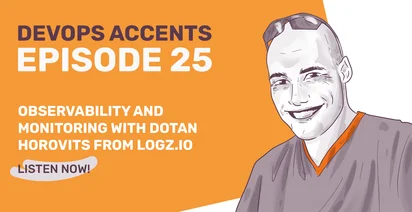Observability and Monitoring with Dotan Horovits from logz.io |🎙️#25

In this episode of DevOps Accents, Pablo and Leo talk to Dotan Horovits, a developer advocate from logz.io
- What is developer advocacy and developer evangelism and why it's not marketing?
- Observability and Monitoring: how important are they in the Pipeline today?
- How did it work before and why is it a separate thing at all?
- Who should interpret the data that this tooling collects?
- Why is it so expensive to have Observability?
- Should each individual developer monitor their own data?
You can listen to episode 25 of DevOps Accents on Spotify, or right now:
In the rapidly evolving world of DevOps and cloud-native technologies, observability has emerged as a cornerstone for ensuring system reliability, performance, and efficiency. With the shift towards microservices and containerized architectures, traditional monitoring tools have had to evolve to address the complexities of modern infrastructure. This episode delves into the significance of observability, the challenges it addresses, and insights from industry experts on navigating these waters effectively.
Understanding Observability
Observability extends beyond traditional monitoring, providing a deeper insight into the internal states of systems through the external outputs they produce. It encompasses metrics, logs, and traces—collectively offering a holistic view of an application's health, performance, and operational dynamics. This comprehensive approach is essential in today's distributed, dynamic environments, where pinpointing issues and understanding system behavior in real-time can be daunting.
The Evolution of Observability Tools
Historically, observability tools were simpler, designed for monolithic architectures with a limited set of failure modes. Modern systems, however, are far more complex, with microservices and containers adding layers of complexity that require advanced tools and strategies. Solutions like Prometheus and Grafana have gained popularity for their ability to tackle these challenges, enabling teams to monitor and analyze data across various dimensions efficiently.
The Cost of Observability
While observability is crucial, it comes with its set of challenges, notably the cost associated with storing and analyzing vast amounts of telemetry data. High-profile cases, such as a notable tech company's annual observability bill running into tens of millions, highlight the need for efficient data management and the strategic use of observability tools. Experts advocate for a balanced approach, focusing on key metrics and employing cost-effective strategies to manage data volume without compromising on insights.
Developer Advocacy and Evangelism
The role of developer advocates and evangelists in promoting observability practices cannot be overstated. Through conferences, blogs, podcasts, and community engagement, they play a pivotal role in educating and guiding the tech community on effective observability strategies. Their efforts not only help in spreading best practices but also in gathering feedback to refine tools and methodologies continuously.
The Future of Observability
Looking ahead, the observability landscape is set to evolve further, with a focus on integrating cost management (FinOps) into observability practices. Initiatives like OpenCost aim to standardize how costs related to observability are defined and managed, promising more transparency and control over observability expenses. Moreover, as the industry moves towards more sophisticated architectures, the integration of AI and machine learning in observability tools is anticipated, offering even more nuanced insights into system behavior and performance.
Conclusion
In conclusion, observability is an indispensable part of modern DevOps and cloud-native ecosystems, enabling teams to maintain system reliability, performance, and efficiency in complex environments. As the industry continues to evolve, the role of observability will only grow in importance, underscored by the continuous innovation in tools and practices aimed at making it more effective and cost-efficient. Through the concerted efforts of the tech community, led by advocates and experts, the future of observability looks promising, with potential breakthroughs on the horizon that will further empower teams to deliver exceptional digital experiences.
Our guest, Dotan:
- personal blog
- professional blog
- Dotan's podcast, OpenObservability Talks
Interesting articles:
- Expensive metrics and the high cardinality problem
- FinOps Observability
- Monitoring Kubernetes Cost and OpenCost project
Podcast editing: Mila Jones, milajonesproduction@gmail.com
